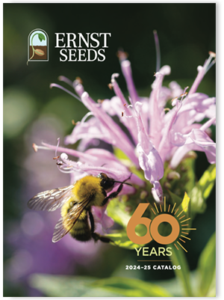As with many practices aimed at solving a problem with ecological solutions, research is showing the ecological and agricultural benefits of a diverse approach to riparian buffer establishment – specifically one that includes the addition of native perennial grasses like switchgrass (Panicum virgatum) and forbs (flowering plants).
These plants are known for their expansive and deep-reaching root systems that have tremendous water absorption and nutrient-gleaning properties. Including them in a riparian vegetation zone along with deciduous trees and shrubs can create an extremely efficient system. They help filter and clean storm water of nutrients, sediment and other harmful matter before it finds its way into the adjoining water body and associated watershed. These riparian forest buffers are also effective at stabilizing stream banks, arresting erosion and minimizing runoff and sedimentation.

Part of the challenge in creating effective riparian buffers is that many of these areas are on working farmland. When this is productive land for crops or pasture for livestock, the economic case needs to be made for farmers to abandon traditional farming activities in favor of water conservation practices.
The United States Department of Agriculture (USDA) has offered subsidy programs to compensate farmers for converting farmland to riparian buffers for many years. In our home state of Pennsylvania, a more aggressive initiative has been in place since 2016 to accelerate cleanup of the Chesapeake Bay Watershed by providing resources and grant funding opportunities to help it achieve a goal of 95,000 acres of riparian forest buffer establishment along the Commonwealth’s 86,000 miles of rivers and streams by 2025.

Riparian areas often occupy marginal land that might not be easily planted with traditional row crops, though they often occupy an expanse of land between crop lands and the water body. These are often the site of pastures for cattle and other livestock. This practice carries particular risk for streams and rivers when livestock enter the water for drinking and when the pastures are not buffered with a swath of vegetation between them. The lack of a barrier allows storm water to run largely uninhibited into the water body, carrying heavy sediment load, manure and agricultural chemicals, among other contaminants. Cattle standing in the water provide a direct source of high phosphorus and nitrogen. Streambanks can be severely degraded as well by the movement of livestock in and out of the stream.

Within each riparian area are suggested zones in which certain types of vegetation are recommended for maximum benefit. The first zone represents the area immediately beside the streambank, out to at least 15 feet from it. In this zone, woody deciduous shrubs are typically recommended. Their soil holding properties anchor the streambank. The shade they provide cools the water and makes it more hospitable to aquatic organisms and fish, while their leaf litter and overhanging foliage introduce insects to the water, feeding those same creatures.
From a purely ecological perspective, a diverse native seed mix containing numerous grasses and forb species, allowed to establish and function as an unadulterated native meadow, will make a tremendous impact on the riparian area, beginning at the inland edge of the wooded first zone, extending out at least 35 feet from the bank, further if possible. Its system of deep and dense roots will filter nutrients from stormwater, remove phosphorus and nitrogen before they reach the stream or river, and provide a lush habitat for insects, specifically pollinators like native bees, honeybees, butterflies and dragonflies. The presence of insects throughout their life cycle will draw birds, reptiles, amphibians and small mammals. Many ground nesting birds will find nesting cover in these mixed grasses.
When a multi-functional, agronomically beneficial solution is desired, switchgrass or other warm season grasses as a monoculture can be a good choice for this wide riparian buffer zone. For starters, their nitrogen retention, phosphorus take-up and soil health improving qualities are superior to other vegetative solutions.

Further changing the economic landscape for switchgrass and other native warm season grasses grown in buffer zones is a growing market for the fiber produced. In the last two years, native warm season grass straw has gained increased acceptance in traditional straw markets due to its longevity and ability to absorb liquids. More people are starting to use the fiber for bedding and mulching uses in place of other traditionally used commodity straws which have a fairly volatile price. The use of the straw in a variety of erosion control products is another market which has seen significant growth. Manufacturers like MKB Company have begun using ground switchgrass and other warm season grasses in products like their Switch Sock® and other erosion and sedimentation control (E&S) solutions. Innovative industries are developing additional uses for this biomass. Compostable, biodegradable foodservice utensils and containers are two examples.
Each riparian area is unique in its topography, hydrology, proximity to agricultural operations and the goals the landowner seeks to accomplish on the site. The riparian buffer options you choose should reflect a thorough consideration of all these factors. Understanding the benefits switchgrass and other warm season grasses bring to the equation may prove advantageous to your riparian buffer planning.
For more information on native warm season grass biomass, or to learn more about Ernst Biomass, LLC, visit our page clarifying details about biomass.


